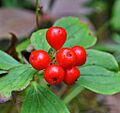Dogwood facts for kids
Quick facts for kids Dogwood |
|
|---|---|
 |
|
| An inflorescence of Cornus canadensis: the tiny flowers are clustered in the centre |
|
| Scientific classification | |
| Kingdom: | |
| (unranked): | |
| (unranked): | |
| (unranked): | |
| Order: | |
| Family: |
Cornaceae
|
| Genus: | |
| Subgenus: |
Chamaepericlymenum
|
| Species: |
C. canadensis
|
| Binomial name | |
| Cornus canadensis |
|
The Canadian bunchberry (scientific name: Cornus canadensis) is a small, beautiful flowering plant. It is also known by other names like Canadian dwarf cornel, quatre-temps, crackerberry, and creeping dogwood. This plant belongs to the Cornaceae family, which is also known as the dogwood family.
You can find the Canadian bunchberry growing naturally in eastern Asia (like Japan, Korea, and parts of China and Russia), the northern United States, Colorado, New Mexico, Canada, and Greenland. Most plants in the dogwood family are large trees or shrubs. But the Canadian bunchberry is different! It's a creeping plant that grows from underground stems called rhizomes. It's a perennial plant, meaning it lives for more than two years. It usually grows to be about 20 centimeters (8 inches) tall.
Contents
What the Canadian Bunchberry Looks Like
The Canadian bunchberry is a slow-growing herbaceous subshrub. This means it's a small, woody plant that doesn't grow very tall, and its stems are not as hard as a tree's. It often forms a soft, carpet-like mat on the ground. Its stems grow up from deep in the soil. These plants can create large groups of identical plants, called clonal colonies, under trees. The stems that grow above ground are thin and do not have branches. The leaves grow opposite each other on the stem. In the fall, the leaves get red veins and then turn completely red, which looks very pretty.
Amazing Flowers
In late spring to midsummer, the Canadian bunchberry produces white flowers. Each tiny flower is only about 2 millimeters (0.08 inches) wide. They have petals that bend backward. These petals are shaped like an egg and are about 1.5 to 2 centimeters (0.6 to 0.8 inches) long. The Stamens, which hold the pollen, are very short, only 1 millimeter long. They are yellowish-white. Many different insects help pollinate these flowers, including bumblebees, solitary bees, bee flies, and syrphid flies. After the flowers, the plant grows fruits that look like berries, but they are actually a type of fruit called a drupe.
How the Bunchberry Shoots Pollen
The Canadian bunchberry has one of the fastest plant actions ever found! Each flower has very stretchy petals. When the flower is ready, these petals flip backward. This action releases springy parts called filaments that were tucked under the petals. These filaments snap upward very quickly, flinging pollen out of tiny containers attached to them. This whole movement happens in less than half a millisecond! The pollen experiences a force that is two to three thousand times stronger than gravity. To capture this amazing action, scientists need a special camera that can shoot 10,000 pictures per second!
Tasty Fruit
The fruits of the Canadian bunchberry are green and round when they start growing. They turn bright red when they are ripe in late summer. Each fruit is about 5 millimeters (0.2 inches) wide. Inside, there are usually one or two hard, oval-shaped seeds, called stones. The fruits are safe to eat and have a mild flavor, a bit like apples. The large seeds inside are quite hard and crunchy.
Where the Bunchberry Lives
The Canadian bunchberry is a mesophytic plant. This means it needs cool, moist soils to grow well. You can find it in mountain forests and boreal coniferous (cone-bearing) forests. It often grows along the edges of damp woods, on old tree stumps, in mossy areas, and in other open and moist places.
How it Helps Nature
Birds are very important for spreading the seeds of the Canadian bunchberry. They eat the bright red fruits during their fall migration and then help spread the seeds to new places. In Alaska, the bunchberry is a key food source for animals like mule deer, black-tailed deer, and moose. These animals eat the plant throughout the growing season.
Related pages
- Jacksonia scoparia, commonly known as dogwood.
See also
 In Spanish: Cornus para niños
In Spanish: Cornus para niños
Images for kids
-
In species like this Cornus × unalaschkensis, the tiny four-petaled flowers are grouped together in the center of four showy white petal-like bracts.
-
Cornus florida in spring
-
Cornus drummondii in flower
-
Mature and immature flowers of Cornus canadensis, Bonnechere Provincial Park, Ontario









